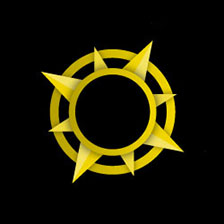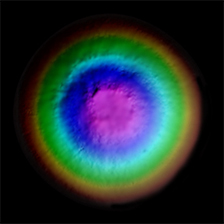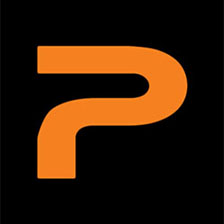Europa Voyager / Galileo Global Image Mosaic Map
- Publisher
- USGS Astrogeology Science Center
- Publication Date
- 2002-01-02
- Abstract
- This sheet is one in a series of maps of the Galilean satellites of Jupiter at a nominal scale of 1:15,000,000. This series is based on data from the Galileo Orbiter Solid-State Imaging (SSI) camera and the Voyager 1 and 2 spacecraft. Mercator and Polar Stereographic projections used for this map of Europa are based on a sphere having a radius of 1,562.09 km. The scale is 1:8,388,000 at ±56° latitude for both projections. Longitude increases to the west in accordance with the International Astronomical Union (1971; Davies and others, 1996). Latitude is planetographic. The process of creating a geometric control network began with selecting control points on the individual images, making pixel measurements of their locations, using reseau locations to correct for geometric distortions, and converting the measurements to millimeters in the focal plane. These data are combined with the camera focal lengths and navigation solutions as input to a photogrammetric triangulation solution (Davies and others, 1998; Davies and Katayama, 1981). The solution used here was computed at the RAND Corporation in June 2000. Solved parameters include the radius (given above) of the best-fitting sphere, the coordinates of the control points, the three orientation angles of the camera at each exposure (right ascension, declination, and twist), and an angle (W0) that defines the orientation of Europa in space. W0-in this solution 36.022°-is the angle along the equator to the east, between the 0° meridian and the equator's intersection with the celestial equator at the standard epoch J2000.0. This solution places the crater Cilix at its defined longitude of 182° west (Davies and others, 1996). This global map base uses the best image quality and moderate resolution coverage supplied by Galileo SSI and Voyager 1 and 2 (Batson, 1987; Becker and others, 1998; 1999; 2001). The digital map was produced using Integrated Software for Imagers and Spectrometers (ISIS) (Eliason, 1997; Gaddis and others, 1997; Torson and Becker, 1997). The individual images were radiometrically calibrated and photometrically normalized using a Lunar-Lambert function with empirically derived values (McEwen, 1991; Kirk and others, 2000). A linear correction based on the statistics of all overlapping areas was then applied to minimize image brightness variations. The image data were selected on the basis of overall image quality, reasonable original input resolution (from 20 km/pixel for gap fill to as much as 40 m/pixel), and availability of moderate emission/incidence angles for topography and albedo. Although consistency was achieved where possible, different filters were included for global image coverage as necessary: clear/blue for Voyager 1 and 2; clear, near-IR (757 nm), and green (559 nm) for Galileo SSI. Individual images were projected to a Sinusoidal Equal-Area projection at an image resolution of 500 m/pixel. The final constructed Sinusoidal projection mosaic was then reprojected to the Mercator and Polar Stereographic projections included on this sheet. Names on this sheet are approved by the International Astronomical Union (IAU, 1980, 1986, 1999, and 2001). Names have been applied for features clearly visible at the scale of this map; for a complete list of nomenclature of Europa, please see Gazetteer of Planetary Nomenclature. Font color was chosen only for readability. Je 15M CMN: Abbreviation for Jupiter, Europa (satellite): 1:15,000,000 series, controlled mosaic (CM), nomenclature (N) (Greeley and Batson, 1990).
Contact and Distribution
- Format
- Global Mosaic
- Access Scope
- Series Id
- 2757
- Native Data Set Environment
- Astrogeology Theme
- Cartography, Image Processing, Remote Sensing
- Mission Names
- Galileo, Voyager
- Instrument Names
- SSI, Voyager 1, Voyager 2
- Online Package Link
- https://astrogeology.usgs.gov/search/map/europa_voyager_galileo_global_image_mosaic_map
- External File Size
- 3131405
- Online File Link
- http://astropedia.astrogeology.usgs.gov/download/Europa/Mosaic/europa_map.pdf
- Access Instructions
- 1 Map: 73 x 81 cm
- Contact Address
- 2255 N. Gemini Drive
- Contact City
- Flagstaff
- Contact State
- AZ
- Contact Postal Code
- 86001
- Contact Email
- astroweb@usgs.gov
Geospatial Information
- Target
- Europa
- System
- Jupiter
- Object Type
- Grid Cell
- Raster Row Count (lines)
- 4799
- Raster Column Count (samples)
- 5100
- Quad Name
- Map Projection Name
- Mercator















